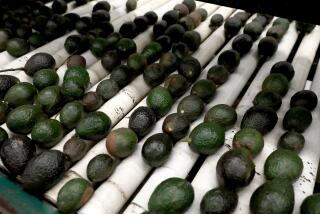Avocados Are Not Just a Pretty Face, They’re Good for You, Too
- Share via
When somebody refers to “functional foods,” do you scratch your head and say: Aren’t all foods functional? Don’t they all provide us with some sort of nutritional advantage, even if it is nothing more than just calories?
It turns out that in the language of the U.S. Food and Drug Administration, and now food producers and manufacturers, the term “functional food” imparts a higher value to certain foods. A “functional food” is defined as one that helps maintain a healthy physique and improves the body. Now that’s still a little vague, but primarily this definition is being used to single out those foods that seem to be naturally blessed with combinations of phytochemicals that may help fight certain chronic diseases such as cancer and heart disease.
We’ve been hearing about broccoli (and many of its cruciferous cousins) in that context for years. Now avocados have been elevated to “functional food” status and are having a phytochemical coming-out party. According to the director of the UCLA Center for Human Nutrition, avocados include a cholesterol-lowering phytosterol called beta-sitosterol, and glutathione, a combination of three amino acids that is said to act as an antioxidant.
In animal studies, phytosterol has been shown to inhibit cholesterol absorption from the intestine, resulting in lower blood-cholesterol levels, and to inhibit the growth of tumors. Meanwhile, glutathione has been linked to the prevention of heart disease and various types of cancer, including cancer of the mouth and pharynx.
In research conducted for the California Avocado Commission, avocados contained more than four times the beta-sitosterol found in other commonly eaten fruits, like bananas, apples, cantaloupes, grapes, plums and cherries. In addition, avocados seem to contain at least twice as much beta-sitosterol as corn, green soybeans and olives. In similar research conducted by the National Cancer Institute in 1992, the glutathione content of avocados was found to be, ounce per ounce, three times that of bananas, apples, cantaloupes, grapes, plums or cherries.
*
The researchers are not saying that avocados are in any way a magic food, but they do believe that this adds to the body of evidence supporting the value of consuming five fruits and vegetables a day. Because getting a variety of fruits and vegetables is crucial, adding avocados will help ensure we get enough of these important phytochemical substances in our diet.
This news is also meant to counteract the impression that avocados are too high in fat to include in a healthy diet. Although they are one of only two fruits or vegetables that are naturally high in fat (the other one is olives), the fat they contain is primarily mono-unsaturated (like olive oil), so avocados can be an important addition to diabetic meal plans and heart-healthy diets.
What else do we know about avocados? They are native to Central America, where it is believed that ancient Aztecs used them as a sexual stimulant.
Today, the only domestic crops come from Florida and California, with California producing almost 90% of them. The most popular California variety is the Hass avocado, which weighs about half a pound and has a thick, pebbled skin that goes from green to an almost purplish black as the fruit ripens. Each fruit has about 177 calories.
Florida avocados are not quite as rich and creamy because they contain less fat, but have only about 112 calories each. It is easy to tell the difference because they tend to be larger and their skin is smoother than California avocados.
Avocados have more potassium than a banana and contain almost 10% of an adult’s daily requirement of iron. Plus, they are very low in sodium, and provide good quantities of beta carotene, vitamins B6, C and E, folic acid and copper. They have the consistency of mayonnaise when mashed but as much fiber as whole-wheat bread or corn on the cob. Because they are vegetable products, they have no cholesterol.
To select avocados, look for fruits free of blemishes. A firm avocado is unripe while a ripe one will yield to gentle pressure from your hand. Be sure they are not overly ripe and starting to rot. If you buy unripe avocados and want to use them in something like guacamole, store them in a bowl at room temperature until they are ripe or, to speed up the process, try putting them in a paper bag with an apple for two or three days.
For the most part, you should not store avocados in the refrigerator. However, if they are ripe, you can keep them there for a couple of days. Longer periods will cause them to discolor and produce unpleasant changes in flavor. They can also be mashed with about one-half teaspoon of lemon or lime juice per one-half avocado and stored in a container covered with plastic wrap that is laid directly on the surface. Once avocados have been prepared this way, they can be kept in the freezer for a month or two.
When you are ready to use a whole avocado, cut it lengthwise around the seed. Gently rotate the two halves to separate them. Remove the seed by sliding the tip of a spoon underneath it and lifting it out. You can then easily peel the avocado or simply scoop out the insides. If they are not overly ripe, they can be cut into slices or cubes.
*
Dr. Sheldon Margen is a professor of public health at UC Berkeley; Dale A. Ogar is managing editor of the UC Berkeley Wellness Letter. Send questions to Dale Ogar, School of Public Health, UC Berkeley, Berkeley CA 94720-7360, or by e-mail to daogar@uclink4.berkeley.edu. Eating Smart runs every Monday.
More to Read
Eat your way across L.A.
Get our weekly Tasting Notes newsletter for reviews, news and more.
You may occasionally receive promotional content from the Los Angeles Times.









